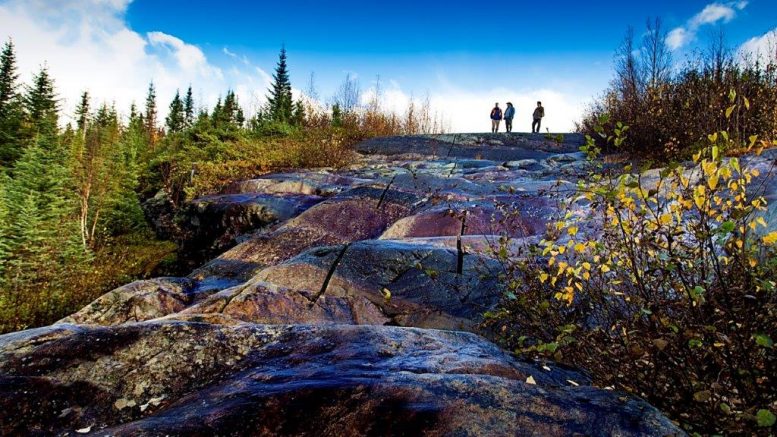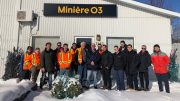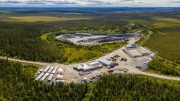VanadiumCorp Resource (TSXV: VRB; US-OTC: APAFF) has released the first resource estimate for the Main zone at its wholly-owned Lac Dore vanadium project in northern Quebec, 27 km east-southeast of Chibougamau.
“Our first mineral estimate exceeded our expectations and shows that Lac Dore is one of the largest and highest-grade vanadium resources in North America,” Adriaan Bakker, VanadiumCorp’s president and chief executive, said in an interview.
VanadiumCorp plans to commence metallurgical studies before the end of the year and next stage economic assessments in early 2021.
Lac Dore contains measured and indicated resources of 214.93 million tonnes grading 0.4% vanadium pentoxide (V2O5), 27.1% iron, 7.1% titanium dioxide (TiO2), and 24.6% magnetite for 2.12 billion lb. of contained V2O5, 58.3 million tonnes of iron, and 15.2 million tonnes of TiO2.
Inferred resources add 86.91 million tonnes grading 0.4% V2O5, 28% iron, 7.6% TiO2, and 25.9% magnetite for 850 million lb. of contained V2O5, 24.4 million tonnes of iron, and 6.6 million tonnes of TiO2.
The vanadium at Lac Dore is hosted by layered zones of vanadiferous titanomagnetite (VTM) that outcrop in a high-grade zone containing 1.3% to 1.4% V2O5 and significant levels of iron and titanium.
The company used the Davis Tube Recovery method to separate the mineralized material into strongly magnetic and weakly magnetic fractions, which allowed it to assess the quantity and grade of the magnetite concentrates and to identify the high-grade massive magnetite zones.
The assays returned magnetite concentrates of 52.82 million measured and indicated tonnes grading 1.3% V2O5, 62% iron, and 8.7% TiO2 for 1.49 billion lb. of V2O5, 32.8 million tonnes of iron, and 4.6 million tonnes of TiO2 and 22.55 million inferred tonnes averaging 1.2% V2O5, 62% iron, and 9.2% TiO2, for 610 million lb. of contained V2O5, 14 million tonnes of iron, and 2.1 million tonnes of TiO2.

Drill core sample from Lac Dore vanadium project. Credit: VanadiumCorp Resource.
Vanadium is highly resistant to corrosion and when added in small amounts to steel and aluminium creates super-light, ultra-high-strength, and resilient alloys. The silvery metal is increasingly being used as a critical component in vanadium flow battery technologies, which use vanadium ions to store energy. The technology promises large-scale energy storage for stationary energy applications, including residential buildings and offices, and could soon power entire cities with the first 800 megawatt-hour vanadium storage battery currently under construction in Dalian, China.
Unlike current methods for processing vanadium that use smelting and roasting to process ore from VTM deposits, which have low-yields of vanadium, produce significant waste and greenhouse gas emissions, and only recover vanadium, VanadiumCorp plans to use a technique called the Vanadium Electrochem Process Technology (VEPT), which is more efficient, greener, and cost-effective, and also recovers the iron and titanium, the company says.
In 2018, VanadiumCorp signed a partnership agreement with Montreal-based Electrochem Technologies and Materials, the developer of VEPT, to commercialise the technology.
“We’ve been working with Electrochem since 2016, with the aim of developing a technology that can recover the iron and titanium as by-products, the sale of which could bring the effective cost of vanadium production potentially down to zero,” Bakker said.
Bakker said that reducing the cost and carbon footprint of vanadium production could lead to environmentally-friendly, low-cost energy storage technologies that have the potential to last up to two or three times longer than current lithium-ion batteries.
Furthermore, when the hardware used in vanadium batteries deteriorates, the vanadium, which makes up about 80% of the battery, can be removed and put in a new battery, he said. The battery’s hardware is also 100% recyclable.
“The government in Quebec is very keen to develop a battery industry and is very supportive of any mine-to-battery plans,” Bakker said, noting that it recently unveiled a $1.4 billion plan to support the battery technology sector.
The Chibougamau area hosts several other low-grade VTM deposits within the Lac Dore Complex, including BlackRock Metal’s Southwest and Armitage vanadium assets, which are adjacent to Lac Dore.
In 2018, the government provided BlackRock with a $248-million funding package to help develop its vanadium resources.
“There is enough vanadium in the Lac Dore Complex to take North America off fossil fuels,” Bakker said.
At press time in Toronto, VanadiumCorp was trading at 6¢ per share within a 52-week trading range of 2.5¢ and 7.5¢. The company has 299 million common shares outstanding for an $18-million market capitalization.





Be the first to comment on "VanadiumCorp says Lac Dore is ‘one of the largest and highest-grade vanadium resources in North America’"